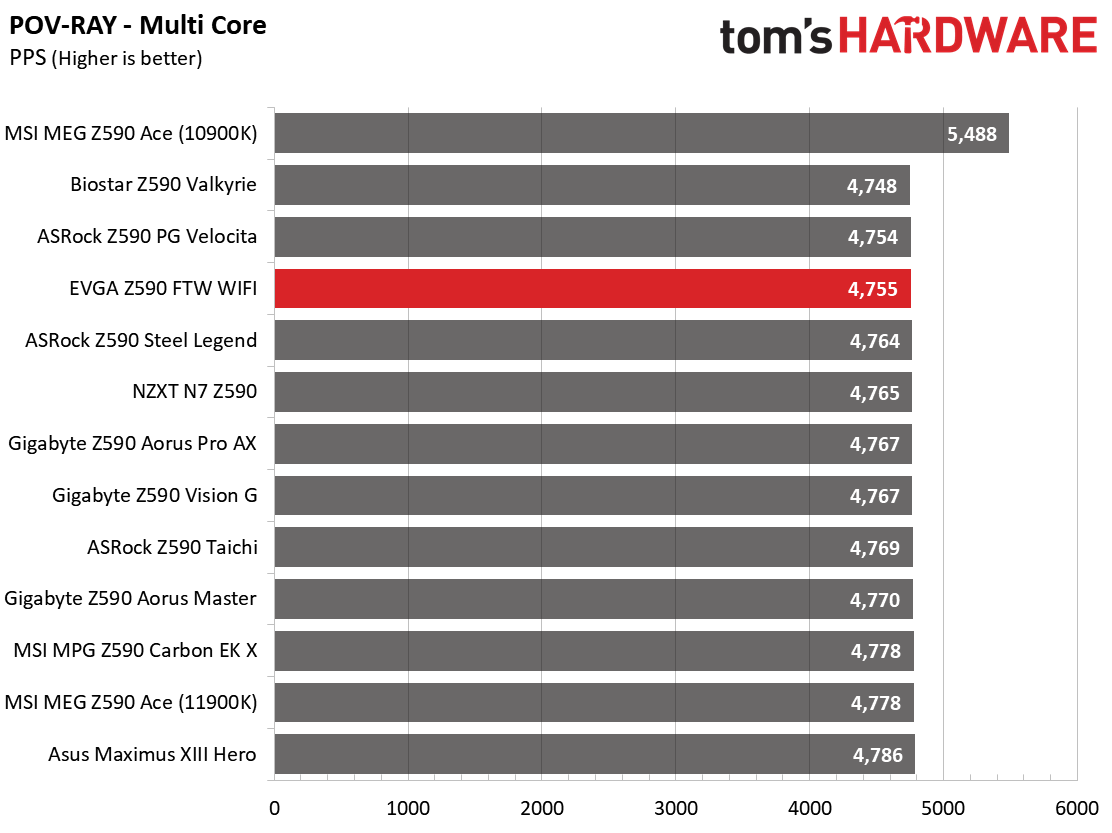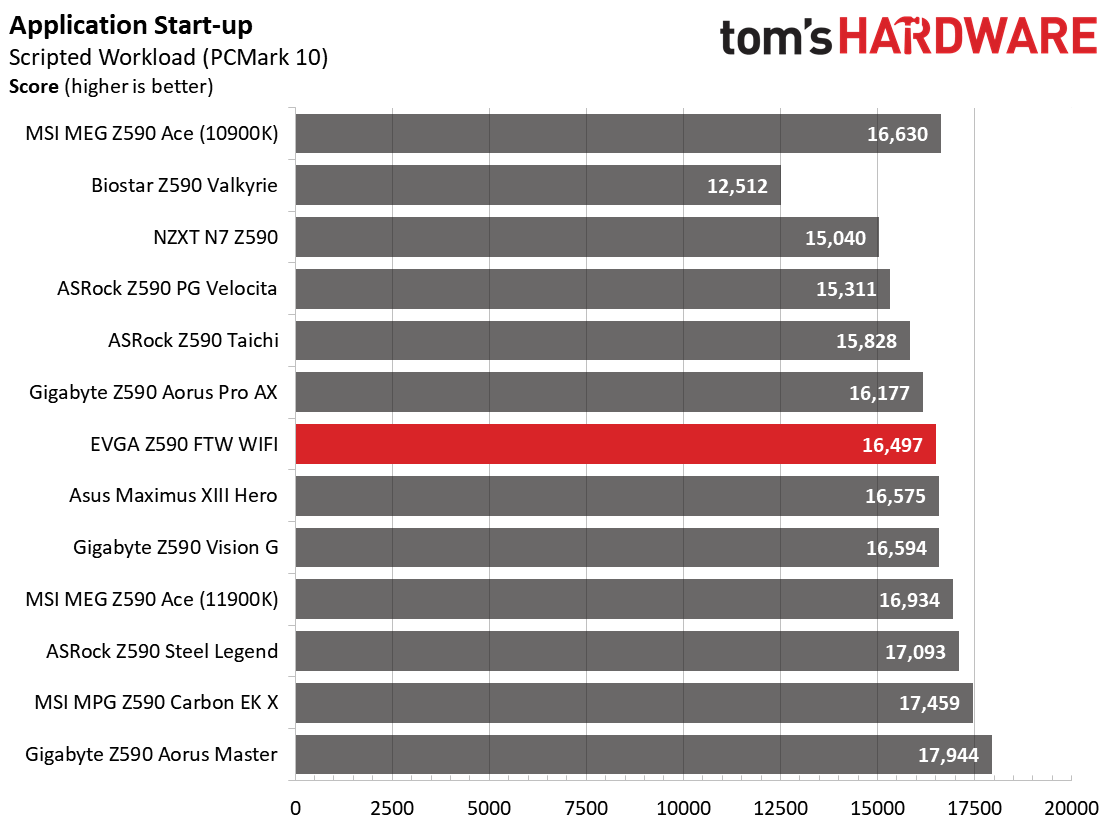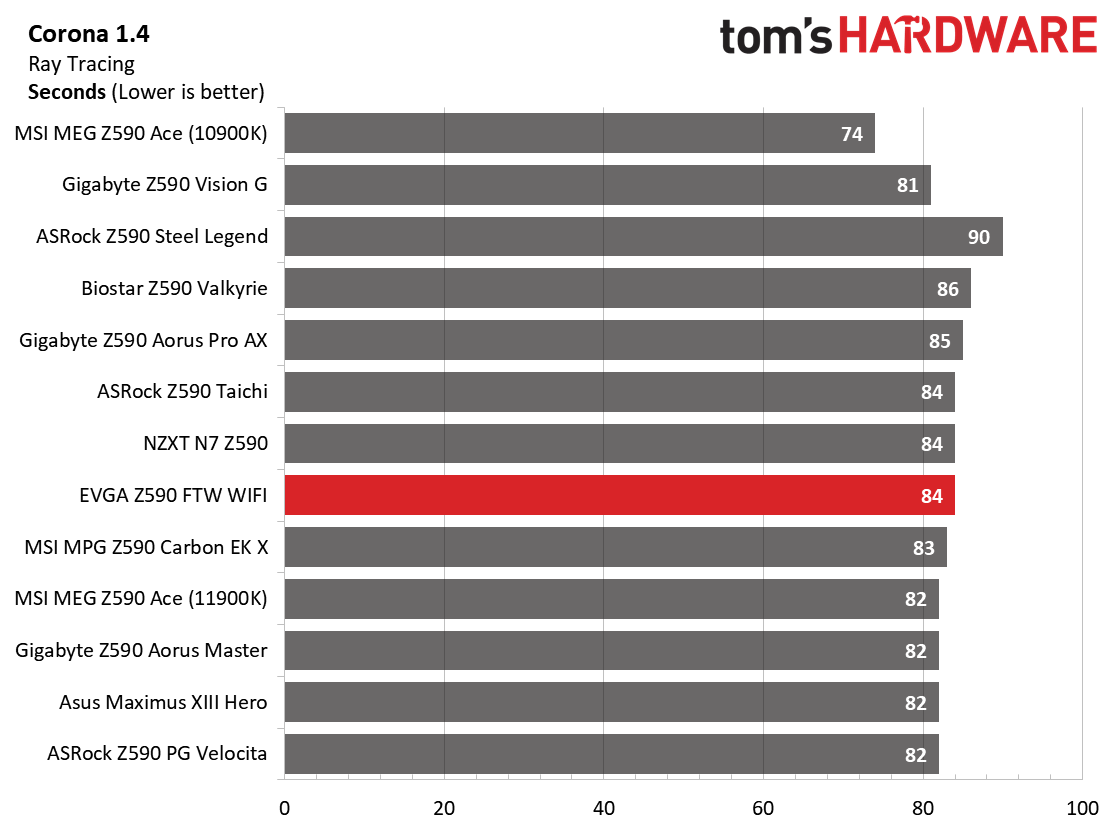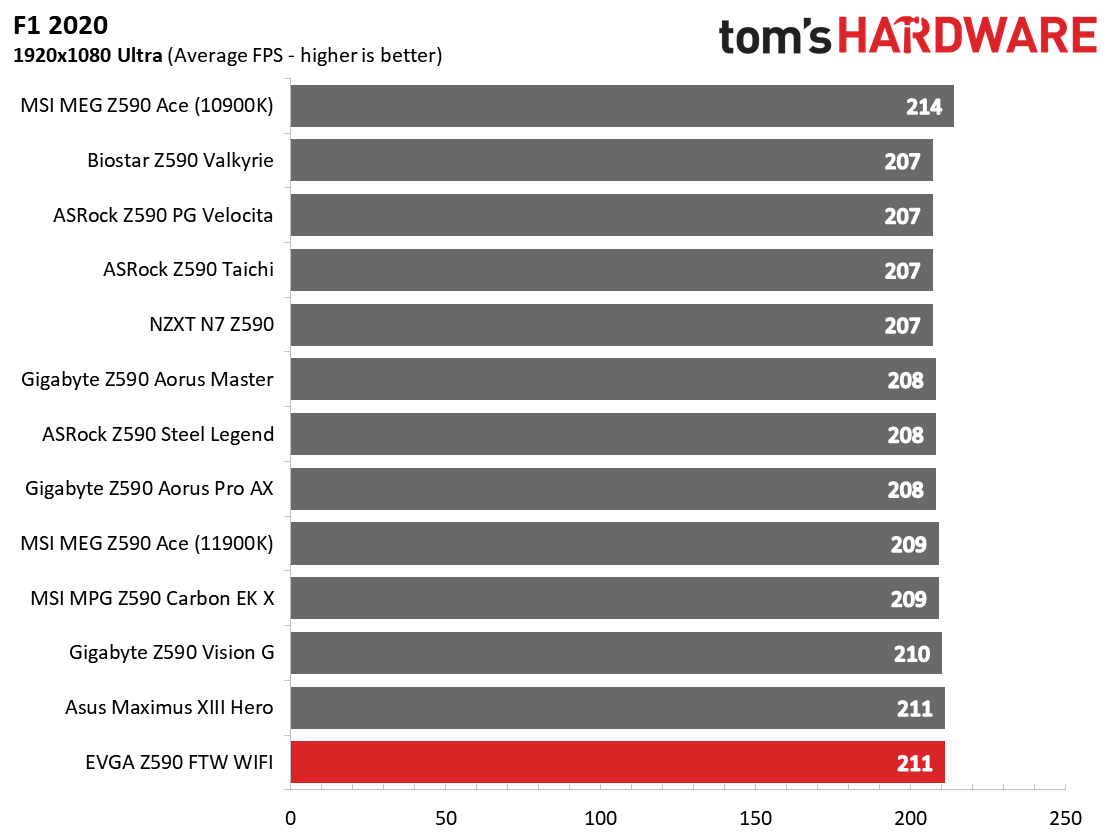Why you can trust Tom's Hardware
Benchmark Results
Our standard benchmarks and power tests are performed using the CPU’s stock frequencies (including stock Thermal Velocity Boost), with all power-saving features enabled. Optimized defaults are set in the BIOS and the memory set using the XMP profiles. For this baseline testing, Windows is set to the balanced power plan.
Synthetic Benchmarks
Synthetics are a great tool to figure out if a board runs out of spec, as identical settings should produce similar performance results. Advanced memory timings are the one place where motherboard makers can still optimize for either stability or performance, though, and those settings can impact some testing.




















When looking at the synthetic benchmarks, the EVGA FTW WIFI fared OK overall. Some tests (Cinebench Single Core, 7Zip Compression, PCMark 10 Suite) were slower than the average. In other tests, it compared well with its peers. In most cases, you’d be hard-pressed to find a difference unless you timed/benchmarked the result.
Timed Applications




LAME testing showed the EVGA WIFI as the slowest Rocket Lake-based result at 12.02 seconds. On the other hand, the Corona test came in at 84 seconds which is about average, a tie for the second-fastest result. Last, the Handbrake testing resulted in a middle-of-the-pack finish.
3D Games and 3DMark




We’ve recently updated our game tests to F1 2020 and Far Cry: New Dawn. The games are run at 1920x1080 resolution using the Ultra preset. As the resolution goes up, the CPU tends to have less of an impact. The goal with these settings is to determine if there are differences in performance at the most commonly used resolution with settings most people use or at least strive for.
In both 3DMark and our real game testing, the EVGA FTW showed its mettle, leading all other tested boards. In both synthetics and games, it topped the charts in a very tight race. However, all gaming results are pretty close, so it would be tough to notice a difference outside benchmarks.
Power Consumption / VRM Temperatures

We used AIDA64’s System Stability Test with Stress CPU, FPU and Cache enabled for power testing, using the peak power consumption value. With Rocket Lake, we need to disable AVX-512 instruction sets; otherwise, temperatures are out of control at stock speeds on some boards. The wattage reading is from the wall via a Kill-A-Watt meter to capture the entire ecosystem. The only variable that changes is the motherboard; all other parts are the same.
Get Tom's Hardware's best news and in-depth reviews, straight to your inbox.
On the power consumption side, the EVGA Z590 FTW WIFI did well, using the second-least amount of power across our tested systems. At idle, the system consumed just 67W while on load, peaking at 252W. This averages out to 160W and is 2W more than the Steel Legend on the low side, and 25W less on average than the PG Velocita at the high end. Overall this is a good showing.




EVGA’s 90A MOSFETs and finned heatsink, unsurprisingly, worked well, easily managing our Core i9-11900K CPU at both stock and while overclocked. When running at stock speeds, the VRM peaked just under 50 degrees Celsius. This result was better than most of the several Z590 boards we’ve tested. When overclocked, the FTW WIFI kept the VRMs just under 60 degrees Celsius, yielding middling results between all of our tested boards. In short, you have nothing to worry about on this front, even when overclocking.
Overclocking
Overclocking on the FTW WIFI was straightforward. We set voltages, disabled and TVB boost(s), and any Adaptive boost, so the clocks hold and are unaffected by these automated features. The BIOS is laid out nicely, with almost everything you need in one menu heading. That said, at the time of testing, voltages were off in CPUz, but Eleet X1 was accurate
When overclocking the i9-11900K, we decided to do so by testing without AVX-512 instructions. When you unlock all of the power limits, you’re thermally limited, with the CPU reaching 100 degrees Celsius in several seconds. Since every board is different in following (or not following) Intel specifications, we’ve removed that variable. The bottom line is that if you need to use these instructions, you’ll need to set a significant offset compared to non-AVX-512 loads. To that end, we settled on a 5.1 GHz overclock at around 1.3V. Our CPU uses around 225W in this configuration, which lands between stock power use (195W) and AVX-512 power use (~265W) and is the end of the line due to thermal constraints.

On the memory front, the Z590 FTW WIFI worked with our DDR4 3600 sticks at a 1:2 ratio (Gear 2) and didn’t have any issues with the DDR4 4000 kit (also Gear 2). AIDA bandwidth and latency tests put the FTW WIFI towards the top of the pack, especially in writes, copy and latency. Again, we had no issues getting these kits to work on this board and BIOS for our limited memory testing.
Final Thoughts
EVGA’s latest iteration of the FTW WIFI board has taken it to another level, at least appearance-wise. However, don’t take that as a knock on the hardware. EVGA boards use quality hardware and robust power delivery, but the looks and RGB limitations have often stood out--this generation mostly fixes that. In the end, the $429.99 Z590 FTW WIFI comes to the table with a 12-phase 90A VRM configuration for the CPU, a USB 3.2 Gen2x2 port, integrated Intel Wi-Fi 6 and more.
Performance out of the box was hit and miss. Where the system lacked in some tests like the PCMark Suite, it excelled in gaming, if only by a small margin. A couple of simple tweaks (adjusting offsets) and it runs just as fast as any other board. That said, in most tests, the difference in performance was slight and nothing to worry about.
As far as improvements are concerned, I would like to have seen a 2.5 GbE port on this board as most others, especially at this premium price-point, include 2.5 GbE. The rear IO plate only has seven USB ports, which will be too few for some users. Sure, there are additional headers to use, but we’d like to see eight-plus on the IO. Some may pick at the Wi-Fi 6 (as opposed to 6E), but at this point, few own routers that reach those speeds in the first place.
There’s a fair amount of competition in this premium space, with some impressive boards vying for your money. This includes the ASRock Z590 Taichi ($459.99), the Asus ROG Maximus XIII Hero ($480.99), and the MSI MEG Z590 Ace ($491.99). In addition, some intriguing parts are priced lower, like the MSI MEG Z590 Unify ($379.99). The most significant difference between these boards and the EVGA comes down to Wi-Fi 6/6E capability (most have 6E and 2.5 GbE), M.2 slot count (Unify has four, the rest have three), USB port count on the rear IO, and of course, looks and price. There are other differences, including audio codec and power delivery. However, most won’t notice the audio, and all of the listed boards easily support our flagship-class CPU, including overclocking. Looks also play a role, and while the EVGA has notably improved for this generation, some may find the other more shrouded and RGB-laden boards fit their build theme better.
Overall, we like what EVGA has done with the Z590 FTW WIFI. However, if you need the latest Wi-Fi capability or faster Ethernet, you’ll have to use add-in cards or select another board. In the end, the EVGA Z590 FTW WIFI is a solid option to build your Z590 PC on. While it doesn’t offer the latest and greatest on some features, there are only a few out there who would truly miss them.
MORE: Best Motherboards
MORE: How To Choose A Motherboard
MORE: All Motherboard Content

Joe Shields is a staff writer at Tom’s Hardware. He reviews motherboards and PC components.
-
Bobaganoosh Thanks for doing this review! As an owner of this board, I'd love it if you shared some of your experience with gear 1 memory timings, or CPU overclock limitations. I'm currently running my 11900k at 5.3GHz-all-core and memory at 3733MHz cl16 gear1. I've seen some other boards with frequency curve offsets, but this board just has a general voltage offset. I'm curious what the best approach with this board is to see if I can get more stability and head towards 5.4GHz+ (at least on 2 cores). My OC Robot seems to think it is possible to do 5.4GHz-AC, but it doesn't like to run there or even with just the 2 *cores there and the others at 5.3. Cheers!Reply
